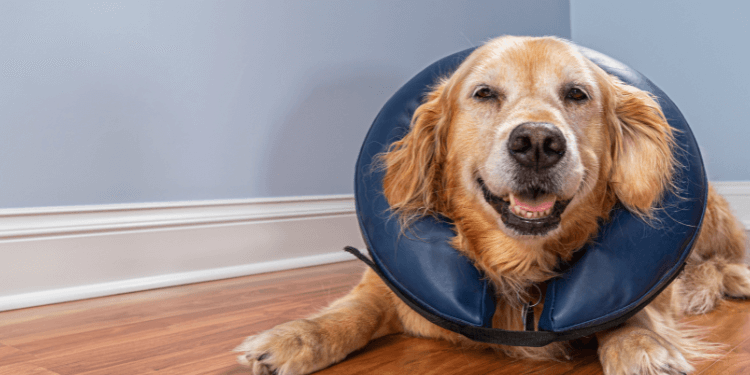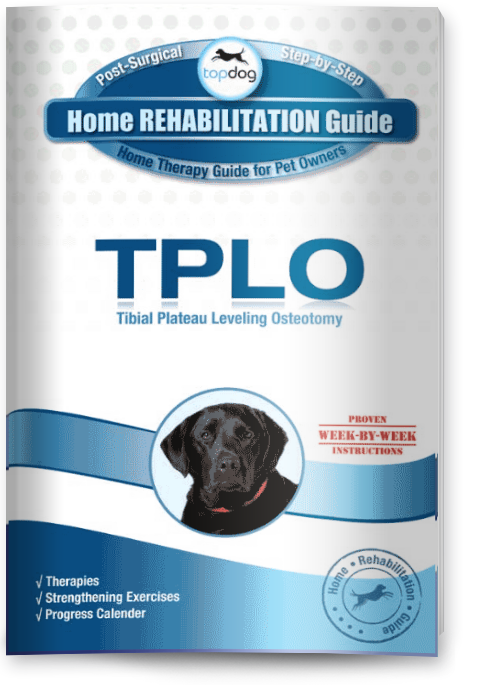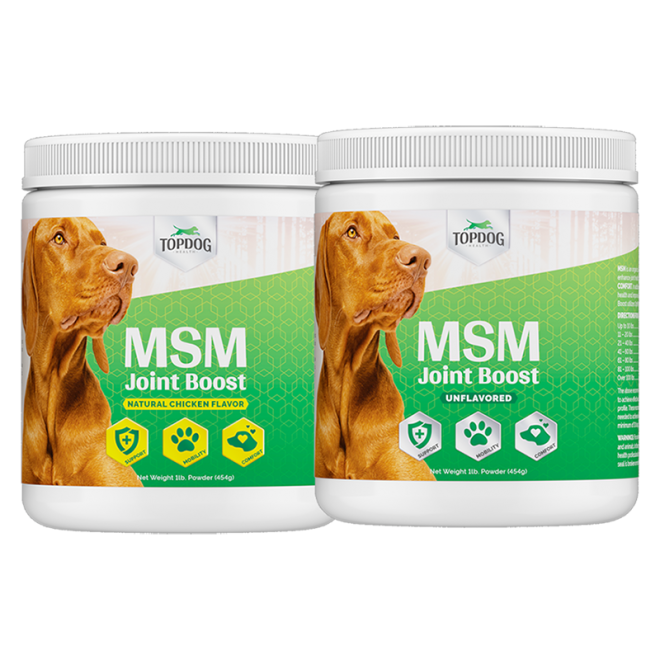Of the many acronyms used in veterinary medicine, TPLO may just be pushing its way to the front of the familiarity pack, especially for those mover and shaker-type dogs. That is because the TPLO (Tibial Plateau Leveling Osteotomy) is becoming more and more popular as a way of fixing a dog’s torn cranial cruciate ligament (CCL). Why is that, exactly? Let’s walk through how a TPLO surgery helps a dog regain their hindleg function.
Dog Knee Anatomy
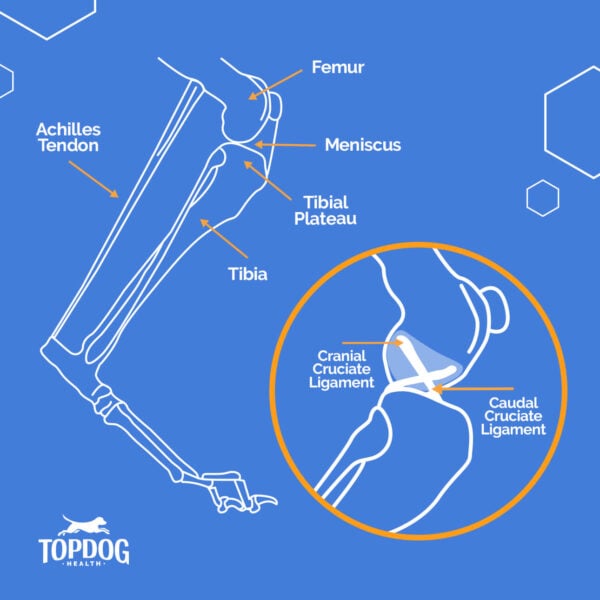
First, a little background information…
The knee of a dog is an amazing hinge joint made up where the end of the thigh bone, the femur, meets the end of the lower leg, or the tibia. These two ends are held together by a group of tendons and ligaments that allow the joint to bend but not rotate, slide, or otherwise wiggle in an unnecessary way.
A couple of those tendons, called the cranial and caudal cruciate ligaments, are located inside the joint itself. This pair forms a perfect X in the center of the joint that prevents the tibia from sliding forward or backward along the femur when weight is put on the leg. These ligaments are extremely important since a dog’s knee joint naturally sits at a bent angle. That means that there is always pressure on them, even at rest. That pressure is really taken to the extreme in pups that have no off button.
Vigorous running, jumping, twisting, and spinning all create a perfect storm for that CCL to tear, allowing the lower leg to slide around in the knee joint, creating inflammation and pain. Because of this, your dog may not want to use that leg, or they may limp or only touch their toes to the ground when they do. Some dogs may even sit with both hindlegs stretched out to one side in order to relieve some of that discomfort.
How are CCL Tears Treated In Dogs?
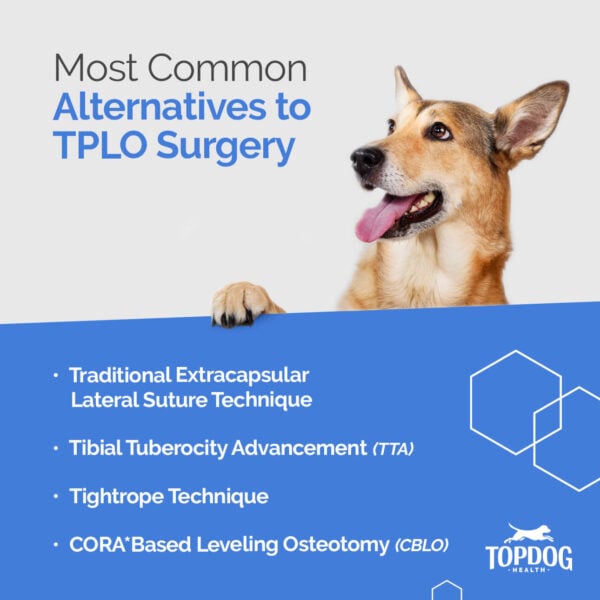
Now, CCL tears are fairly common in people, although we refer to them as ACL tears when dealing with the two-legged variety. And the vast majority are repaired by replacing the torn ligament with a piece from another area of the body, a synthetic, or even a pig ligament in order to return the joint to normal function. This type of repair doesn’t exist in the animal world, mainly due to the size and cost of dealing with a dog’s knee.
Instead, veterinarians have to resort to a little creativity to stabilize the joint in other ways. Some of those ways, namely the lateral suture and the TightRope surgeries, create a fake ligament outside of the joint that does the same job as a CCL. Others actually alter the angles within the knee joint in order to make it so the CCL isn’t needed anymore. And that’s where the TPLO comes in. Along with the TPLO, you have the CORA Based Leveling Osteotomy and the Tibial Tuberosity Advancement that alter the joint structure in order to cover for the torn CCL as well.
- Traditional Extracapsular Lateral Suture Technique
- Tibial Tuberosity Advancement (TTA Surgery)
- Tightrope Technique
- CBLO (CORA Based Leveling Osteotomy)
What is TPLO Surgery for Dogs?
When you’re looking into altering the angles within a knee joint, you may expect that there’s a lot of math and physics involved, and, indeed, there is. But before you decide to quit reading this for fear of a math quiz, let me just say that the math is straightforward and you won’t be asked to do any of it! Instead, the veterinarian is going to take a pre-op x-ray to see what the angle is between the end of the femur and the end of the tibia.
Before surgery, this is going to be a downhill slope with the back of the tibia dropping off. Let’s think of the femur as a sled and the end of the tibia as a snow-covered slope. When that CCL is intact and working, it keeps the sled tied to the top of the hill, preventing it from sliding. Once that ligament is torn, the sled is free to careen backwards down the hill. When this is repeated when a dog moves the leg, you’re going to get a lot of inflammation and pain.
What the vet plans to do is to level out that downhill slope since sleds won’t slide on their own on a flat surface. Using the x-ray, the vet will make a note of the flat angle they want to achieve and then figure out how much rotation needs to take place to get there.

Once in surgery, your pup’s knee will be opened up using an incision in the skin over the knee joint. The muscles will also be moved to the side so that the vet can assess any damage, remove torn cartilage, and start changing the angle of the tibia. Using a bone saw, a circular cut will be made in the end of the tibia, freeing up the back part of the joint which makes up the downhill slope.
That small piece of bone will then be rotated to the predetermined angle so that it flattens out that joint surface, making it more difficult for the bones to move in ways they aren’t supposed to. This prevents the femur from sliding backward and the tibia from sliding forward when weight is put on the joint. Instead, they’ll just hinge on each other as they should without extra movement. As you’ll remember, this used to be the job of the CCL but with this change in the joint angle, it isn’t needed anymore.
The bony piece is then fixed into place using a bone plate and screws that will allow the piece to reunite with the rest of the tibia just in a new position. Instead of having a rounded and sloping tibial end in the knee joint, you now have a flattened surface.
Once the bone is secured, the muscles will be moved back into place and the skin and underlying tissues will be closed. Some vets prefer closing with sutures while others like staples. Staples are usually chosen since they are faster to put in and generally cause less of a reaction. The cut bone will heal similar to the way a fracture will and your dog’s new, realigned joint will be as stable as if it had a brand new, untorn CCL.
What To Expect With TPLO Surgery
Even though the injury to your dog’s CCL often comes on quickly and shockingly, the TPLO surgery does not. You’ll have time to prepare. Many dogs will first visit their regular veterinarian due to lameness or not wanting to use their hindleg. Some dog owners will actually witness the inciting injury and hear the sickening pop that sometimes comes with a CCL tear.
After x-rays and manipulation of the leg, often under sedation, your vet will diagnose a CCL tear and talks of treatment will begin. Deciding how to treat the leg will depend on a few different things.
- Your dog’s activity level, age, weight, health, etc.
- What surgeries are available either through your vet or a local specialist.
- What you can afford. TPLOs and other such surgeries can be expensive.
If the TPLO surgery is your dog’s best option, you’ll be scheduled with your vet, if they happen to perform it, or they will refer to a specialist. Most of the time, these surgeries can be done within a few days of diagnosis. Your pup may be given anti-inflammatories and pain meds until surgery can be done.
The Day of TPLO Surgery
In order to better handle anesthesia, you’ll be asked to withhold food and water from your pup for 8-10 hours. This means that most will get a small supper but then nothing afterward or on the morning of surgery. Pre-anesthetic bloodwork will be done, if it hasn’t already, to make sure your dog’s organ function and blood count can handle anesthesia and surgery.
Some vets may give you antibiotics to start beforehand. Your dog may also be on anti-inflammatories. Be sure to ask if your vet wants you to give these medications on the day of surgery.
Your dog will be sedated, and additional x-rays may be taken as well if needed. From there, they will go under anesthesia, and the leg will be shaved and prepped for surgery.
Under Anesthesia
Going under anesthesia seems like a scary and otherworldly thing. Fortunately, veterinarians have many ways of monitoring a dog’s functions while they are in this deep sleep to make sure everything is okay. Dogs will have a heart monitor and pulse ox machine that will measure their heart rate and oxygen levels. A technician will also be regularly checking oxygen and anesthetic flow and adjusting it as needed.
Most dogs will be under anesthesia for 1 1/2-2 hours, with the actual surgery taking 45 minutes to an hour. The additional time under anesthesia is for surgery prep and recovery.
After TPLO Surgery
When the skin is closed and the vet is satisfied with the surgery, your pup will taken to recovery. Here they will be removed from anesthesia and allowed to wake up gradually. They will still be monitored and kept warm until fully awake.
Most vets will ask that your dog stay the night so that they can get a good look at the incision and how well your dog is feeling the next day. There may be some swelling and bruising of the incision which is usually handled by icing. The vet will also want to look for any drainage from the incision.
Since this surgery involves cutting bone and messing around in the knee joint, there is going to be some pain. Your vet will prescribe anti-inflammatories and pain medications to help with this. Some dogs may even need some sedatives to keep them calm and still for the recovery weeks ahead. Of course, antibiotics will be given to help prevent, and infection and most dogs will get an e-collar to keep wandering tongues out of the incision.
Your vet will have a complete list of recovery instructions, including rechecks, rest requirements, physical therapy, and the benefits of joint supplementation for you to take home. The recovery period is every bit as important as the surgery, so important that we’ve devoted another article just to it, so be sure to check that out as well!
With proper recovery, most dogs will be back to their active, crazy selves by about 12 weeks post-op.
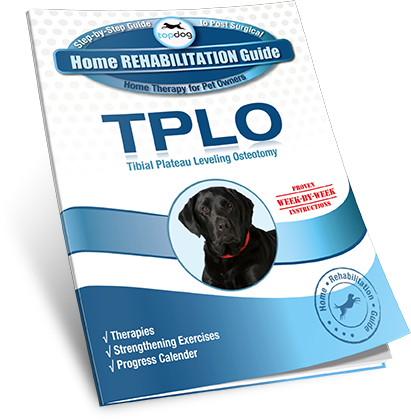
98% of Pet Owners Say this Guide is a Must for Recovery
Final Thoughts
Tearing a CCL is the most common orthopedic injury in dogs, and the TPLO surgery is one of the most common ways of fixing it. All of this is to say that TPLO surgeries are done a lot. There has been plenty of time and practice put into this procedure so that it is as safe and effective as possible. If your vet recommends a TPLO surgery to fix your dog’s torn CCL, don’t be afraid to ask as many questions as you need and check out all of our information so that you and your dog can feel comfortable and have the most successful surgery possible.
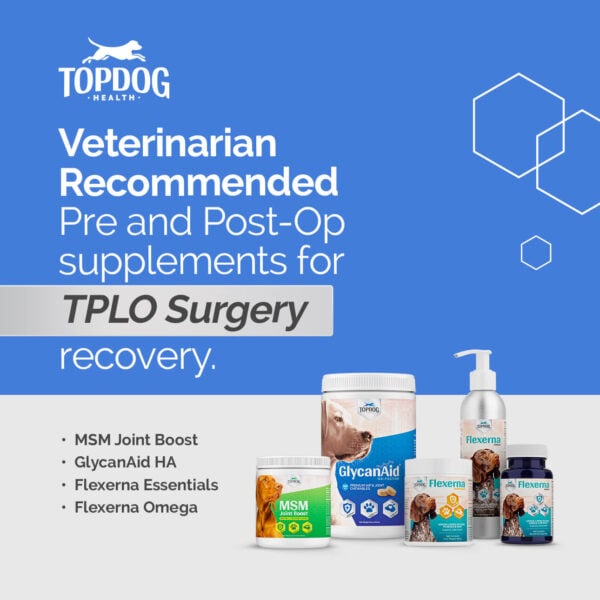
Visit Our Shop!
GlycanAid® HA
$42.95 – $163.95Our max-strength daily joint health supplement was made for dogs over 7 yrs of age or dogs that have had orthopedic surgery or existing compromised joint health. Veterinarian-formulated with medical-grade ingredients that target all aspects of joint health. A full 25mg of hyaluronic acid per dose plus all the essential building blocks (glucosamine & chondroitin ) and effective anti-inflammatories (MSM, Cetyl Myristoleate & Vitamin C) result in happier, healthier more comfortable joints to maintain an active lifestyle.
Flexerna Omega®
$41.95Flexerna Omega® is a daily omega-3 joint supplement designed for dogs of all ages to naturally support their joints and improve everyday comfort. Veterinarian-developed, utilizing pure cold-processed green-lipped mussel extract (25 mg per pump or 50 mg per capsule). Every dose includes up to 90+ fatty acids, including EPA, DHA & ETA, shown to have powerful natural anti-inflammatory benefits resulting in a more noticeable comfortable, happier & active dog.
Flexerna Essentials Green-Lipped Mussel & MSM
$29.95Veterinarian-formulated 100% pure green-lipped mussel (GLM) enhanced with Opti-MSM®. This clinically effective, daily joint powder can be used alone or as a BOOSTER to any existing joint supplement. An amazing all-natural source of chondroitin, vitamins, mineral and proteins for healthy cartilage and the anti-inflammatory support that maintains daily comfort. With only actives, no fillers or binders this is a great solution for dogs that are on a whole food or RAW nutrition diet.
MSM Joint Boost
$26.95 – $29.95MSM Joint Boost is a single ingredient daily joint health solution for dogs of all ages and breeds. Can be used alone or as an added booster to your dogs existing joint supplements. We use human-grade, Opti-MSM®, that targets the root cause of joint pain and inflammation. Our veterinarian-formulated, research-backed, naturally-occurring compound will have your dog feeling better and playing longer for years to come.


